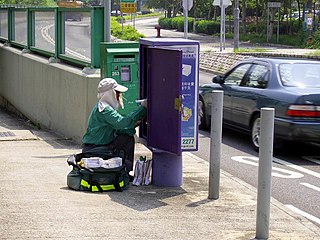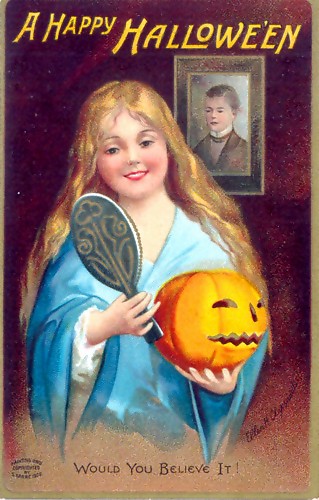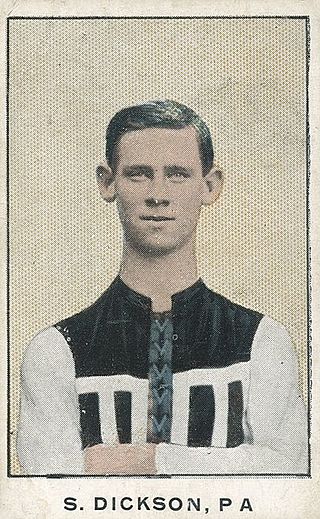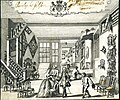
The mail or post is a system for physically transporting postcards, letters, and parcels. A postal service can be private or public, though many governments place restrictions on private systems. Since the mid-19th century, national postal systems have generally been established as a government monopoly, with a fee on the article prepaid. Proof of payment is usually in the form of an adhesive postage stamp, but a postage meter is also used for bulk mailing.

A postcard or post card is a piece of thick paper or thin cardboard, typically rectangular, intended for writing and mailing without an envelope. Non-rectangular shapes may also be used but are rare.

Cigarette cards are trading cards issued by tobacco manufacturers to stiffen cigarette packaging and advertise cigarette brands.

A Christmas card is a greeting card sent as part of the traditional celebration of Christmas in order to convey between people a range of sentiments related to Christmastide and the holiday season. Christmas cards are usually exchanged during the weeks preceding Christmas Day by many people in Western society and in Asia. The traditional greeting reads "wishing you a Merry Christmas and a Happy New Year". There are innumerable variations on this greeting, many cards expressing more religious sentiment, or containing a poem, prayer, Christmas song lyrics or Biblical verse; others focus on the general holiday season with an all-inclusive "Season's greetings". The first modern Christmas card was by John Calcott Horsley.
A trading card is a small card, usually made out of paperboard or thick paper, which usually contains an image of a certain person, place or thing and a short description of the picture, along with other text. When traded separately, they are known as singles. There is a wide variation of different types of cards.

A baseball card is a type of trading card relating to baseball, usually printed on cardboard, silk, or plastic. In the 1950s, they came with a stick of gum and a limited number of cards. These cards feature one or more baseball players, teams, stadiums, or celebrities.

A trade card is a small card, similar to a visiting card, formerly distributed to advertise businesses. Larger than modern business cards, they could be rectangular or square, and often featured maps useful for locating a business in the days before house numbering. They first became popular at the end of the 17th century in Paris, Lyon and London.

A greeting card is a piece of card stock, usually with an illustration or photo, made of high quality paper featuring an expression of friendship or other sentiment. Although greeting cards are usually given on special occasions such as birthdays, Christmas or other holidays, such as Halloween, they are also sent to convey thanks or express other feelings.
Deltiology is the study and collection of postcards. The word originated in 1945 from the collaboration of Professor Rendell Rhoades (1914-1976) of Ohio and colleagues at Ohio State University. A biographical sketch of Dr. Rhoades's life by his wife Nancy was provided to the Canadian Friends (Quaker) Historical Association in 1994. Dr. Rhoades had responded to a contest by editor Bob Hendricks in Post Card Collectors Magazine to create a more scholarly name for the hobby of postcard collecting. 'Philocartist' was a term used in the early 1900s, possibly coined by the noted early philatelist Fred Melville in his 1903 publication The A.B.C. of Stamp Collecting.

The T202 Baseball cards, also known as the Hassan Triple Folder were baseball cards manufactured and distributed by the American Tobacco Company in 1912. The cards were inserted into packs of "Hassan Cork Tip Cigarettes". Several characteristics make this vintage card a standout amongst other forms of tobacco advertising of the time and lend to its value as a highly sought-after collectible.

A hockey card is a type of trading card typically printed on some sort of card stock, featuring one or more ice hockey players or other hockey-related theme and are typically found in countries such as Canada, the United States, Finland and Sweden where hockey is a popular sport and there are professional leagues. The obverse normally features an image of the subject with identifying information such as name and team. The reverse can feature statistics, biographical information, or as many early cards did, advertising. There is no fixed size or shape of hockey cards, running the gamut from rectangular to circular, however modern North American cards have typically standardized on a 2.5-by-3.5-inch rectangular format.
Loyalty marketing is a marketing strategy in which a company focuses on growing and retaining existing customers through incentives. Branding, product marketing, and loyalty marketing all form part of the customer proposition – the subjective assessment by the customer of whether to purchase a brand or not based on the integrated combination of the value they receive from each of these marketing disciplines.

Jefferson R. Burdick (1900–1963) was an American electrician and a collector of printed ephemera, including postcards, posters, cigar bands, and other types of printed materials dating from the mid-nineteenth century to the early 1960s. He is best known for collecting trading and baseball cards in The American Card Catalog, otherwise known as the ACC.

Ellen Hattie Clapsaddle was an American illustrator/commercial artist in the late 19th and early 20th centuries. She is recognized as the most prolific souvenir postcard and greeting card artist of her era.

Wings is an American brand of cigarettes, currently owned and manufactured by Japan Tobacco. As a subsidiary of giant British American Tobacco, Wings, along with some of B&W's other cigarette brands were sold in Europe.
Prizes are promotional items—small toys, games, trading cards, collectables, and other small items of nominal value—found in packages of brand-name retail products that are included in the price of the product with the intent to boost sales, similar to toys in kid's meals. Collectable prizes produced in series are used extensively—as a loyalty marketing program—in food, drink, and other retail products to increase sales through repeat purchases from collectors. Prizes have been distributed through bread, candy, cereal, cheese, chips, crackers, laundry detergent, margarine, popcorn, and soft drinks. The types of prizes have included comics, fortunes, jokes, key rings, magic tricks, models, pin-back buttons, plastic mini-spoons, puzzles, riddles, stickers, temporary tattoos, tazos, trade cards, trading cards, and small toys. Prizes are sometimes referred to as "in-pack" premiums, although historically the word "premium" has been used to denote an item that is not packaged with the product and requires a proof of purchase and/or a small additional payment to cover shipping and/or handling charges.

The history of advertising in Britain has been a major part of the history of its capitalist economy for three centuries. It became a major force as agencies were organized in the mid-19th century, using primarily newspapers and magazines. In the 20th century, It grew rapidly with new technologies, such as direct mail, radio, television. In the late 19th century, home-based British agencies were swallowed up and became branches of international firms, but London remains one of the world's most important advertising centers. Radical changes have come recently because of the new roles for the Internet and smart phones. For current conditions see Advertising.

T200, also known as Fatima Team Cards, were a type of cigarette card issued in 1913 by the Liggett & Myers Tobacco Company (L&M) through the Fatima cigarette brand. The set featured photos of professional baseball teams. The 'T200' designation comes from the American Card Catalogue, an authoritative guide to trading cards issued prior to 1951.

An Australian rules football card is a type of trading card relating to Australian rules football, usually printed on cardboard, silk, or plastic. These cards feature one or more Australian rules football players. Cards are almost exclusively found in Australia as no top-level leagues are present outside the country. Prices for Australian rules football cards can be very high. This is illustrated for both vintage and modern cards such as an 1894 American Tobacco Company card featuring Essendon player Will Crebbin which sold for $10,110 in 2018 and a 2004 Select AFL Conquest Triple Brownlow Medallist signature card featuring Nathan Buckley, Adam Goodes and Mark Ricciuto which was valued at $3,000 in 2018.

The history of postcards is part of the cultural history of the United States. Especially after 1900, "the postcard was wildly successful both as correspondence and collectible" and thus postcards are valuable sources for cultural historians as both a form of epistolary literature and for the bank of cultural imagery included in the postcard illustrations reflecting historic popular culture norms and tropes. Postcards are also valuable resources for scholars of architectural and regional history.































